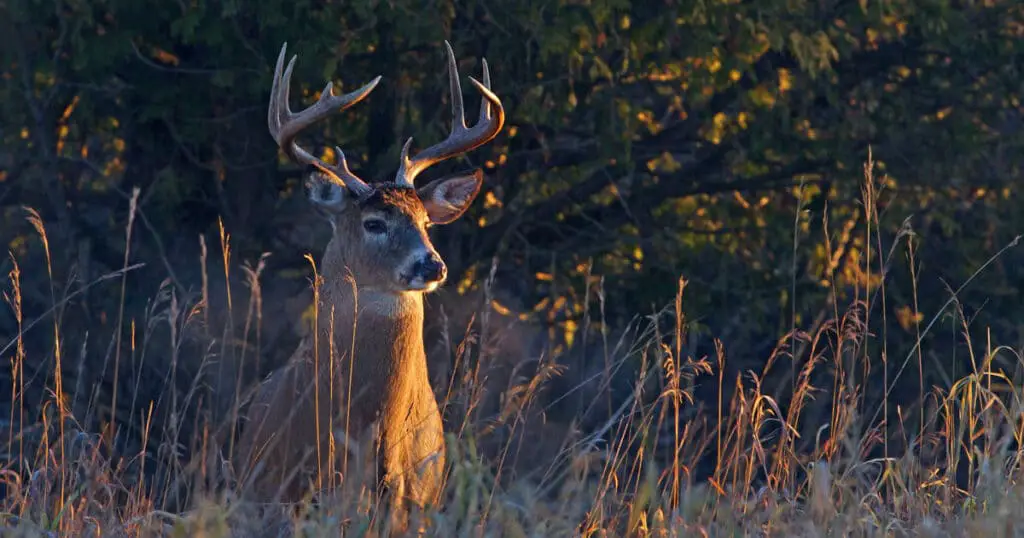While different types of deer have different habitat preferences, there are some common features hat deer look for to stay safe from hunters and predators. Let’s explore the ideal deer habitat conditions in today’s article, and take a look at how deer live, move, and eat to better understand the environmental conditions which best allow deer populations to thrive.
In this article, we’ll explore those activities, and how the types of predators deer populations need to avoid plays a part in the choice of habitat of different types of deer.
In Short: The Ideal Deer Habitat
The deer is a highly adaptable animal, and many deer species can thrive in different kinds of environments. The place where deer do best, however, is in forested environments, or in places where they have access to woodlands. In a forested habitat, deer have:
- a safe place to elude and escape from predators,
- a comfortable place to bed down and rest,
- sufficient forage to eat and remain healthy, and
- adequate cover to conceal and raise their young.
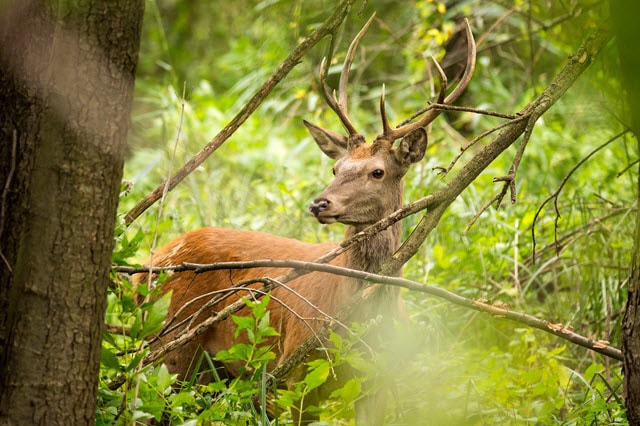
Most species of deer require good cover to deliver their young and raise them. This is because they use cover to help conceal fawns from predators, often leaving them hidden during the day for extended periods – something which is extremely important to a young deer’s survival. The forest also provides numerous food sources for a deer to exploit.
A deer’s quality of life depends on their habitat. After all, they get their food from their habitats, and the quality and quantity of food may vary per habitat.
How Does a Deer’s Diet Impact Where They Live?
Deer must live in a habitat that gives them a dependable and nutritious food source.
Deer eat only vegetation, and of course, forests are a great source of that type of food. However, deer aren’t able to forage on absolutely every type of plant or part of plant. And not every part of a plant or type of plant is ideal for deer nutrition.
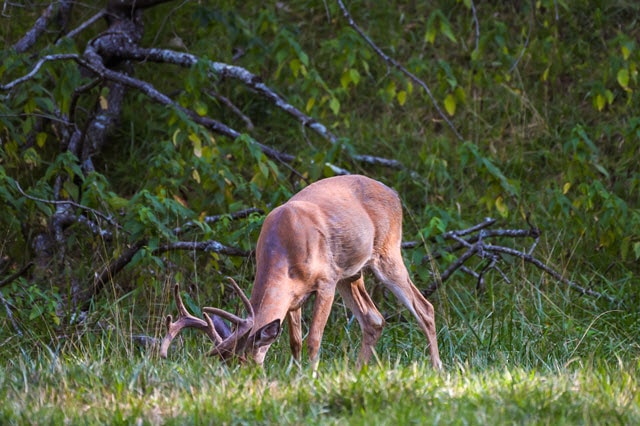
Fortunately, deer are able to recognize which kinds of vegetation are best for them. They can sense the nutrition they need, and they can get a sense of whether the vegetation before them is good for them.
Part of the deer’s adaptability is how they’re able to decide whether they should eat something depending on where they are and the time of year. Deer are intelligent to understand that the nutritional needs they have changes with the seasons and where they are in their annual reproductive cycle.
What Makes Good Deer Habitat?
A high-quality habitat for deer will offer a combination of grasses, forbs, shrubs, vines, trees, and other plants such as sedges and fungi. In each of these plant categories, specific plant species are better for deer than many others.
In whatever area a deer lives, it will more likely thrive if the foods it needs are well spread out over the entire area. This makes the entire area an excellent habitat for deer. There should also be an excellent level of diversity in the kinds of plants available. After all, deer need different kinds of plants to cover their nutritional requirements and keep their digestive system in balance.
Deer Nutritional Needs Shift Season-to-Season
Certain kinds of vegetation are used by deer in just one season, or even just part of a specific season. For example in the fall deer will consume mast such as fallen apples, acorns, and other nuts.
Male deer need foods higher in nutrition when growing antlers, and female deer need more nutrition when pregnant or nursing their babies (fawns).
The Importance of Cover for Deer to Thrive
Deer also use plants to give them concealment, to help them hide from predators. In order for a deer to do well and thrive, it needs cover and food from plants all year round, and they should be high-quality.
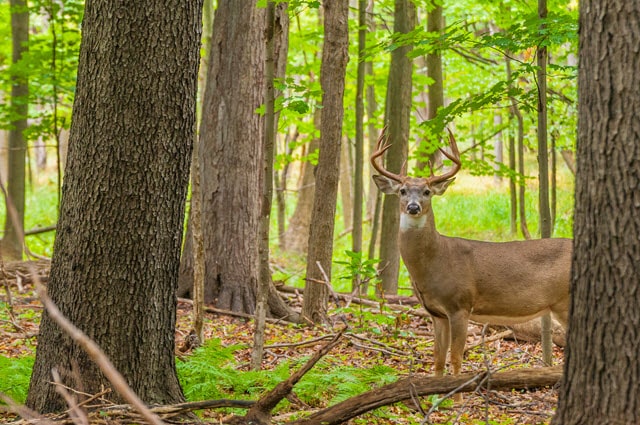
The forested areas that many deer inhabit should have rich soils that are able to grow the right kinds of foods for deer. Deer must have a diverse selection of woody plants and forbs. A forb is a flowering plant with broad leaves and soft stems. This category covers the most significant species of flowering plants. There are several forb species that many people refer to as weeds, but to a deer these leafy plants are a key part of their diet.
Deer usually gravitate to specific kinds of forbs instead of most kinds of grasses and woody plants. Many forbs tend to be the most significant kinds of plants that deer eat. Forbs often offer a higher level of protein and are often easier to digest than some other kinds of vegetation.
There must be a sufficient number of woody plants that will give the deer concealment, shelter, and food, but if the forest doesn’t supply sufficient leafy vegetation, you may see deer venturing out to neighboring grasslands.
Fresh Water is Another Requirement for Good Deer Habitat
Of course, there must also be a substantial water source as well.
Deer should be able to find water to drink at around each mile that they travel.
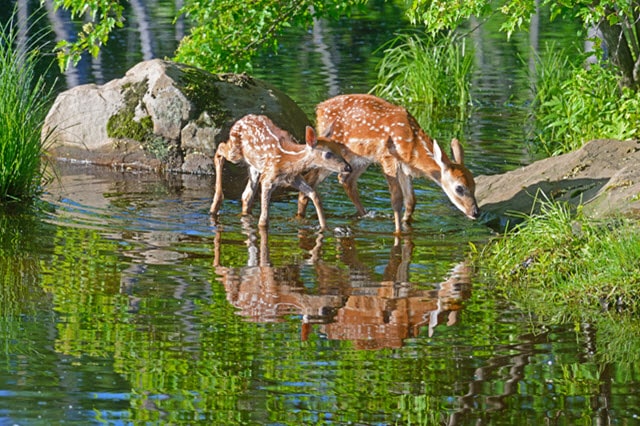
In the spring, deer tend to make forbs around 66 percent of their diets. In the summer, these types of plants make up about 81 percent of a typical white tailed deer’s diet. Come fall, about 69 percent of deer’s food should be forbs. And in the winter, about 46 percent of a deer’s diet is made up of forbs. That is because in that season, there are fewer forbs available.
What is Deer Habitat Improvement or Management?
We must use techniques of deer habitat management in order to keep deer populations healthy and thriving. An example is how people living in areas habituated by white-tailed deer may make adjustments to help the habitat of that species.
When it comes to white-tailed deer management, this species must have two main kinds of food: forbs (this includes weeds the deer find palatable) and different kinds of browse.
Like other deer species, white-tailed deer also require adequate cover and concealment, to help hide them from predators. Some causes of degradation of deer habitat include many kinds of human land-use and exploitation, including harvesting timber, ranching, and improper agricultural practices.
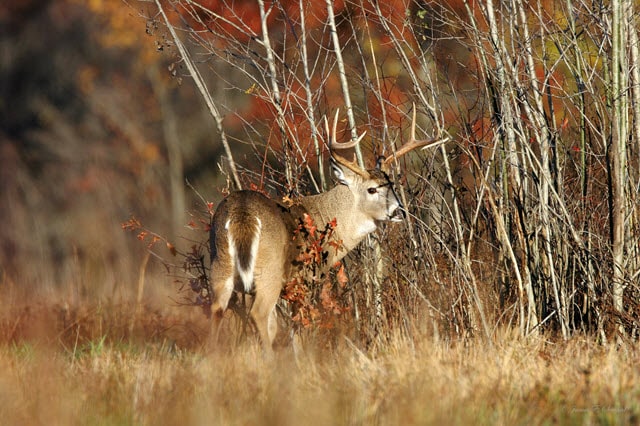
Let’s take a look at some of the methods of improving deer habitats:
Deer Habitat Improvement Methods
Brush management is a way of improving deer habitats. Some experts refer to this as “axe,” as cutting is needed to manage and control brush. If brush management is needed to improve environments for deer, and it’s not done in the right way, deer populations will suffer.
Culling may be necessary in some circumstances if there is overpopulation of deer. Of course, impartial experts will be needed to ensure that overpopulation is indeed the case before culling should occur. That is because if there is over-hunting, it will threaten the viability of a deer population and its habitat.
Another tool that can be used when necessary is using the “plow.” This involves restoration of habitat, as well as creating special food plots for the deer. Another technique is referred to as “cow.” This involves using cows for specific grazing in particular areas. Cows can thin out saplings and small trees and improve forage quality for deer.
What is a Forest or Woodland? (and why is it great for deer)
The words “forest” and “woodland” are frequently used to mean the same thing. Technically, however, they have different meanings.
For an area to be scientifically classified as a woodland, it should have enough tree coverage to ensure the canopy or the overstory provides between 30 and 80 percent closure. Deer need woodland or forest with enough tree cover and vegetation to survive and stay healthy.
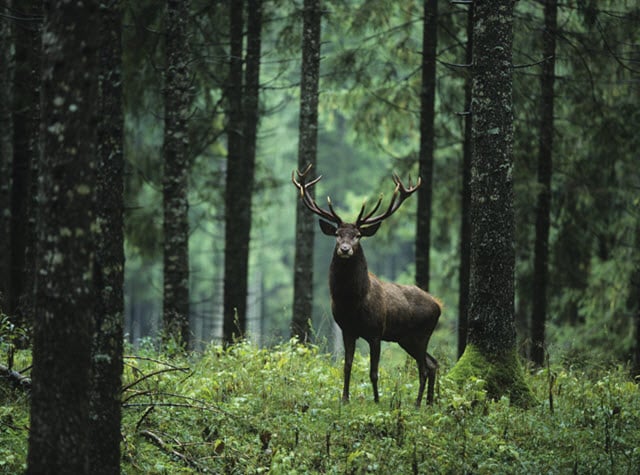
If a woodland is more open in nature and features trees that have more space between each other, it may be referred to as a savanna. This type of environment tends to have a higher proportion of trees that are tolerant to fire, including black jack oaks, burr, and post.
When a space is a real forest instead of just a woodland, it will usually boast a closed tree canopy. For there to be a forest stand, it will be comprised of numerous tree layers in a canopy. As mentioned earlier, deer need sufficient woodland cover and vegetation in order to survive and keep their population at the right level.
Deer Population Changes Throughout the Seasons
Even in areas where white-tailed deer have a strong population, the number of animals present will fluctuate throughout the year. We see this in the white-tailed deer species, and other species of deer around the world.
Of course, there is a rise in population when births take place in the spring. There are also population boosts if new deer arrive in the area. This is referred to as immigration.
There is a decrease in populations whenever deer disperse or depart from the area (referred to as emigration) or when they die, either from predation, natural causes, or hunting.
The later parts of the spring to early summer are when deer populations tend to be highest, because of the new fawns that are born. There’s also the greatest availability of high-quality forage at this time of year.
However, when we get further into the summer, we see a limited fall in population resulting from predators catching fawns.
In the fall, surplus deer tend to be hunted by humans, and this brings down the level of population further. The lowest deer populations tend to be in the middle to late part of the winter.
This is a result of a number of different factors, including disease, starvation, and predation.
Seasons and Habitats
Obviously, the effect of seasons on a habitat will impact how appropriate it is for deer, and how many deer that habitat can sustain.
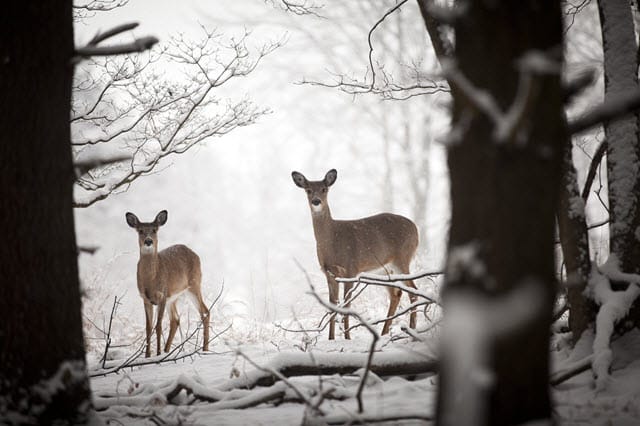
We see this in the habitats of white-tailed deer, and in other species.
In the snow-free months, these deer are able to live in pretty much any and all bushy and forested areas where there is enough food. However, when the winter and snow arrive, deer generally head to what experts refer to as “deer yards.”
Deer Yards are areas where the deer are better able to find appropriate shelter from deep snow and storms, as well as sufficient food. In some cases, deer must travel long distances to reach these deer yards.
White-Tailed Deer Habitat and Regions
A highly adaptable animal, the white-tailed deer lives in a wide range of regions all over North America.
You may find white-tailed deer extending from the boreal (also known as the northern coniferous) forest down to the continent’s southern-most tip. This deer may be seen even in areas as northerly as Great Slave Lake. Some place in southern Canada where the white-tailed deer live range from the southern to central part of British Columbia all the way east to Cape Breton Island.
And it’s important to note that there isn’t just one kind of white-tailed deer. In fact, we know of 16 white-tailed deer subspecies on the North American continent. Just a few of these live in Canada.
In that country, one of the white-tailed deer adapted to the environment is the northern white-tailed deer. There are populations of this species all over eastern Canada. The northern white-tailed deer lives in habitats such as the forest fringe areas around the prairies, parklands, and valleys (also referred to as brushy draws).
Another white-tailed deer sub-species is the Dakota white-tailed deer. This tawny deer lives not only in Dakota but also in southeastern parts of British Columbia. Sometimes it is seen traveling down into Alberta over what we call the continental divide, specifically on its eastern slopes.
How Human Activities Impact Deer Populations
There are several different human activities that can impact and destroy deer habitats.
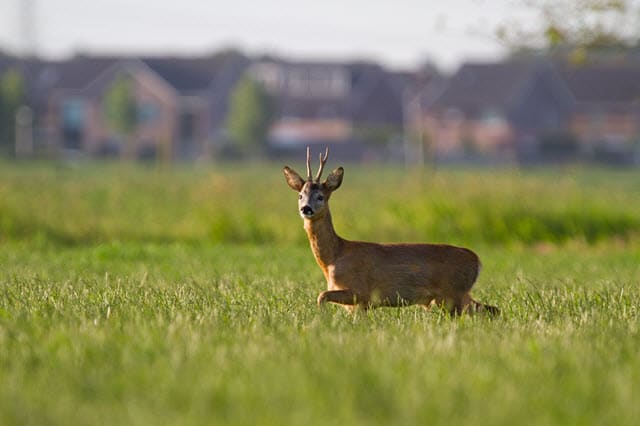
Examples include:
- agricultural crop expansion and seeding,
- tree cutting and forest burning,
- residential development,
- hunting, and more.
Fortunately in many cases, white-tailed deer have been able to grow its populations to the west and north of where they were previously because of new regulations regarding hunting.
Deer Habitat and Adaptation
The way that deer as a species are adaptable has aided their survival, and as habitats change due to climate change, human development, and other factors, deer adapt to those changes and find new ways to thrive.
How Food Sources Determine Habitats
Deer must have continued access to the foods they need in order to make a habitat home. As their natural habitat gets destroyed by human development, it’s not uncommon to see deer coming into the suburbs to browse on plants in residential gardens.
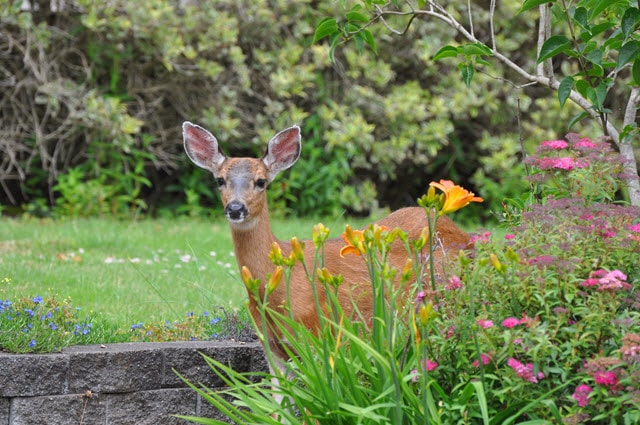
While this causes some people to see deer as pests, it’s simply a natural form of deer adapting to a changing habitat.
As touched on earlier, deer tend to migrate to friendlier environments when the winter arrives. It’s important to realize, however, that these areas tend to attract so many deer that it becomes oversaturated.
When this occurs, there will be too much demand on the food supply available in that winter habitat. The fodder full of nutrition will soon be in short supply. Another issue that makes this worse is deep piles of snow.
Whenever snow piles are taller than 40 centimeters, it becomes even more difficult for deer to reach all the food they would be able to find otherwise. To make matters more challenging, in extreme circumstances, deer end up expending more energy as they search for food than they can find in nutrition.
How Do Deer Hide from Predators?
We’ve already mentioned how brush and other kinds of vegetation are important tools for helping deer hide from predators. There are other methods that these animals use too, however.
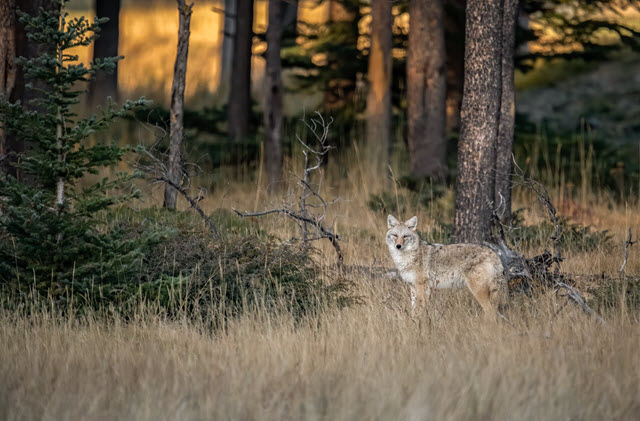
For example, if worst comes to worst, a deer will run. And deer can run at significant speeds, as fast as 30 miles per hour. They’re incredibly agile, and in many circumstances they can use their powerful athletic abilities to thwart predators.
Deer also have outstanding hearing. This helps them detect predators and escape before an attack occurs. Deer are also extremely good at jumping, and they can swim quite long distances, too. This animal’s side-facing eyes are extremely effective at detecting motion.
Another way deer help protect themselves from predators is by living in groups, called herds.
We see this in white-tailed deer, which live in herds and family groups. They especially stay close to one another during the winter months. Every individual deer will make noises and signals to alert the others in its group to any potential danger in the area. One of the signals this deer species often utilizes is to lift their easily recognizable white tails, revealing the white spot beneath.
If they’re forced to, a white-tailed deer will try to fight off predators. Of course, this isn’t an ideal circumstance, and that is why these deer will do everything they can to prevent predators from seeing and stalking them in the first place.
When it comes to fighting off predators, male deer have the advantage in their antlers.
Where Do Deer Live and Sleep?
We’re so used to seeing deer moving around during the day we sometimes don’t think about how they stay safe when sleeping at night. This is yet another reason why it’s so important for these animals to have the right kind of environment with the right type of cover.
Let’s take a look at some of the other elements of deer sleep and staying safe at night.
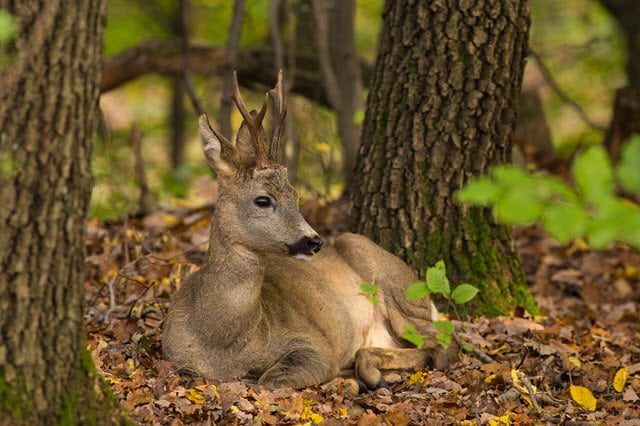
Deer must sleep in a cautious way. That sounds counterintuitive, but these animals have evolved and have the characteristics necessary to keep a certain amount of awareness even when they’re most vulnerable. They generally don’t sleep all through the night hours. Instead, they will take what might be called cat naps, only letting themselves doze off for limited time periods.
Deer are especially selective about where they sleep during winter, choosing bedding sites on south-facing slopes warmed by the sun, with plenty of cover to use.
Also remember they live in groups. Each individual animal may sleep at a different time, letting other stand sentry and give the alert if there is danger nearby. This will usually take the form an audible snorting noise, though some deer (like the Indian Muntjac) have a distinctive bark.
As it’s so difficult to predict exactly when deer will be sleeping, it’s tricky for predators to use the darkness as a way to make hunting easier. To help counteract the detrimental effects of the darkness, deer tend to walk in the opposite direction to the wind. This helps them more quickly detect the scent of predators nearby.
And if you find deer sleeping in your yard, it may just be the safest place in their local habitat to bed down.
What Does a Deer Habitat Look Like? It Depends.
Like any other animal, deer require specific kinds of habitats in order to stay healthy and thrive. The exact environmental requirements depend on the specific type of deer in question.
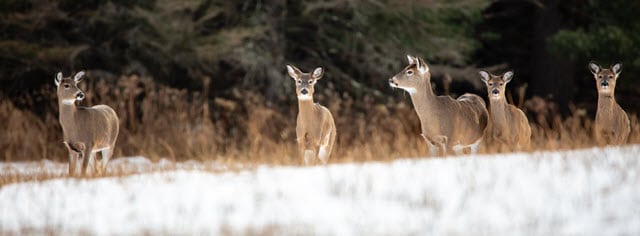
Some small Asian deer species prefer dense underbrush they can easily navigate but predators cannot. Caribou or Reindeer have adapted to thrive in frigid conditions, with female reindeer able to grow antlers to dig in the snow for food.
Regardless of species, however, if a deer population lacks the right kind of environment, they will probably die out and disappear from the region. This, in turn, is likely to have a detrimental effect on the environment as a whole.

